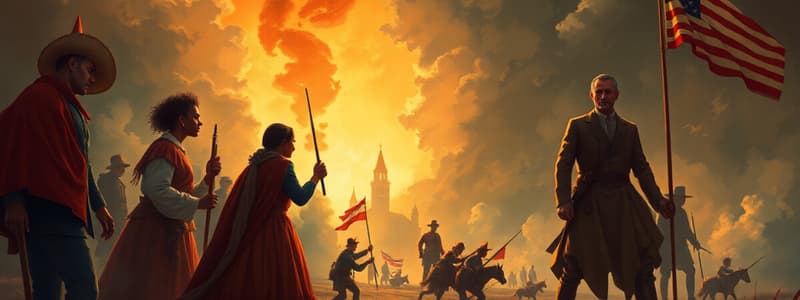Podcast
Questions and Answers
Where was slavery firmly established in the United States?
Where was slavery firmly established in the United States?
- The Midwest
- The South (correct)
- The North
- The West Coast
The Emancipation Proclamation was issued in 1862 to promote the expansion of slavery.
The Emancipation Proclamation was issued in 1862 to promote the expansion of slavery.
False (B)
What amendments abolished slavery and granted rights to black men?
What amendments abolished slavery and granted rights to black men?
13th and 14th Amendments
The period following the Civil War is known as the __________.
The period following the Civil War is known as the __________.
Match the following terms with their descriptions:
Match the following terms with their descriptions:
What ideology justified territorial invasion in the context of colonization?
What ideology justified territorial invasion in the context of colonization?
Racism improved significantly for Black people after the Civil War.
Racism improved significantly for Black people after the Civil War.
Who coined the term 'Manifest Destiny'?
Who coined the term 'Manifest Destiny'?
Legal permanent enslavement was introduced in the __________.
Legal permanent enslavement was introduced in the __________.
Which crop boomed in the Southern colonies and contributed to the rise of slavery?
Which crop boomed in the Southern colonies and contributed to the rise of slavery?
Flashcards
Slavery's Southern Establishment
Slavery's Southern Establishment
Slavery was primarily established in the Southern United States due to agricultural needs, particularly for plantation crops like tobacco and cotton.
Flashpoint: North vs. South
Flashpoint: North vs. South
The central conflict between the North and South was the institution of slavery and its expansion into new territories.
Emancipation Proclamation (1862)
Emancipation Proclamation (1862)
Abraham Lincoln's 1862 declaration that freed enslaved people in Confederate states during the Civil War.
13th & 14th Amendments
13th & 14th Amendments
Signup and view all the flashcards
Reconstruction Era
Reconstruction Era
Signup and view all the flashcards
Post-War Black Situation
Post-War Black Situation
Signup and view all the flashcards
"Cult of Conquest"
"Cult of Conquest"
Signup and view all the flashcards
Mexican-American War (1846-1848)
Mexican-American War (1846-1848)
Signup and view all the flashcards
Manifest Destiny
Manifest Destiny
Signup and view all the flashcards
Triangle Trade
Triangle Trade
Signup and view all the flashcards
1660s & 1662
1660s & 1662
Signup and view all the flashcards
American Founding Fathers
American Founding Fathers
Signup and view all the flashcards
Declaration of Independence (1776)
Declaration of Independence (1776)
Signup and view all the flashcards
Causes of Continued Slavery
Causes of Continued Slavery
Signup and view all the flashcards
Virgin Land Metaphor
Virgin Land Metaphor
Signup and view all the flashcards
Impact of Virgin Land Belief
Impact of Virgin Land Belief
Signup and view all the flashcards
Indian Removal
Indian Removal
Signup and view all the flashcards
Study Notes
Chapter 2
- Slavery was firmly established in the South, based on agriculture.
- The issue of slavery fueled conflict between North and South.
- The Emancipation Proclamation was issued in 1862.
- The 13th Amendment abolished slavery.
- The 14th Amendment granted voting rights to Black men.
- Reconstruction Era followed the Civil War.
- Racism remained entrenched in the minds of white people, despite the end of slavery, leading to continued inequality for Black people.
Additional Information (Page 2)
- "Concept of Conquest" refers to the ideology used to justify territorial expansion and invasion.
- The Mexican-American War was prompted by westward expansion.
- Colonial expansion westward was a significant motivator for the war.
- The concept of slavery began with the English arrival in Jamestown in 1607.
- The transatlantic slave trade facilitated the growth of the enslaved population in the Americas.
- The years 1660 and 1662 were crucial in the history of Black people, marking the legalization of slavery and hereditary enslavement respectively
- American Founding Fathers included Thomas Jefferson, John Adams, and Patrick Henry.
- The Declaration of Independence emphasized the concept of all men being created equal and endowed with inherent rights.
- Slavery continued due to factors like increased land cultivation, especially cotton and tobacco production.
Additional Information (Page 3)
- "Virgin Land" is a metaphor for the newly settled lands, suggesting a fresh start and opportunity.
- Colonists viewed the indigenous peoples as savages and justified their dispossession through narratives of manifest destiny.
- Colonists used disease as a weapon against indigenous populations.
- Colonists established religious beliefs and traditions in the new land.
- Colonists used various forms of violence and oppression to dominate and displace indigenous peoples.
- Colonists used the concept of the "white race" to legitimize their expansion and justify the displacement of indigenous populations.
Studying That Suits You
Use AI to generate personalized quizzes and flashcards to suit your learning preferences.




